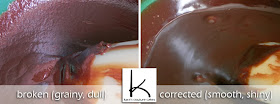I posted this last week on my Facebook page just as a thoughtful piece about what had gone wrong in my kitchen as I was making CuPig. I figured if I could help save anyone else's ganache it would be worth the few minutes to jot down my thoughts. And WHOA! Did you guys like it! I was shocked at the wonderful reaction, so I'm going to archive it here to be easily found forever... The text is my original post. Stay with me; I was a bit wonky that day!
***Ganache Tip***
Have you ever made ganache and had it look like the pic on the left? That's a broken ganache. That's what reared its ugly head in my kitchen this morning. I knew it was a possibility because of my cream. But I live on the edge: I went for it anyways and used the cream to make the milk chocolate ganache.
But that is not an acceptable final product for ganache no matter what you are using it for. So how to fix it...
First, let me tell you what I used and why it happened (just in case you are interested or want to understand why this might happen to your ganache). If I were to get all scientific on you I would explain that it's a fat-in-water emulsion with an excessive dispersed phase that has caused the separation. But ain't nobody got time for that nonsense!
What that means is that the cream (that was mildly separated, but still good) added too much fat to the chocolate. I use a milk chocolate so I made a 3:1, Chocolate:cream, ganache. The fat was too much. (It can also happen if you stir it too much at too low of a temp, so just put down your spatula and step away from the bowl, people!) How to fix?
Heat some skim (or reduced fat) milk to a simmer and VERY slowly add it to the broken ganache stirring all the while. Only add a bit at a time until it becomes smooth and shiny once again. The water added from the (significantly) lower fat milk helps to open up the fat molecules and properly restore the emulsion.
Et, voilà! Beautiful ganache once again.
This concludes how to fix the things Kara inadvertently breaks while caking. As you were people.
***It's good to note that if you add too much heated milk you can inadvertently soften the ganache past what may be usable for your purposes, like if you're covering a cake with it prior to fondanting. Just test the consistency before applying as usual. Even if it's just a bit softer it tends to work for sculpted cakes and definitely for filling. No matter what, it's not a lost cause, it can be used in one way or another in your kitchen.
***General guidelines for ganache ratios:
- Dark Chocolate - 2 parts dark chocolate : 1 part cream
- Milk and White Chocolates - 3 parts chocolate : 1 part cream
That concludes "Saving Your Ganache". Happy caking :)

No comments:
Post a Comment